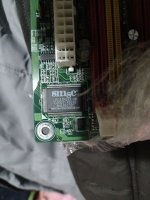Chuck(G)
25k Member
I don't think so. The basic silicon support just isn't there. Some early LPC super I/O chips allowed for reconfiguring the printer port as a second floppy port (I think mostly intended for laptops), but this isn't one of them.
I don't think so. The basic silicon support just isn't there. Some early LPC super I/O chips allowed for reconfiguring the printer port as a second floppy port (I think mostly intended for laptops), but this isn't one of them.
I can't answer that, but if you're still doubtful, why not write Abit directly and get a definitive answer--or inquire if anyone with the same board has ever gotten two floppies to work on, say, Vogons.org? I can only speculate that the BIOS and document were appropriated from an earlier revision of the board or a related board.
I don't think so. The basic silicon support just isn't there. Some early LPC super I/O chips allowed for reconfiguring the printer port as a second floppy port (I think mostly intended for laptops), but this isn't one of them.
Sorry, you're still limited to one drive. In the pinout, note that there's only one drive select and one motor control line.,

SMSC is now owned by Microchip, but here's the detail that you should observe:
View attachment 1267503
So, sorry. Very few boards past P3/Socket 754 support more than one floppy. In particular, motherboards manufactured much after 2005 are unlikely to have two-drive support.
These datasheets involve a lot of cut-and-paste, so at times, inapplicable information gets included. To that point, do you see any explicit reference in the pinout to nDS1 or nMT1? Indeed, in the configuration information back in chapter 11, only the type of floppy drive A: is recognized.
But you could have determined this yourself with a little close reading.
You do expect errors in the publications, and try to reason through them. Get some of the datasheets for advanced MCUs--many of those run in excess of 2,000 pages. Of course errors will be expected. A developer hopes that they will be mostly correct.
Any reason that you're fixated on 775 boards? Drop back a generation to a P4 board and there are boards that support 2 drives very well, such as the Advantech AIMB-742. I run one with one of my tape systems using a 3.1 GHz cpu and it works very well on Linux and Windows 7. Even has a socket for a CF card.
That's going to be pretty tough. Maybe there's an AsRock or Advantech board out there that has all that. The problem, of course, is timing of features. By the time PCIe and SATA2 were on their way in, floppies were on the way out. Check industrial PC manufacturers--they tended to hang onto legacy features longer. Say, Advantech or Supermicro. You may be better off steering away from Intel and going with AMD.
Any particular reason that you need 2 floppy drives? Would 1 legacy floppy and say, an LS120 drive do the job?
